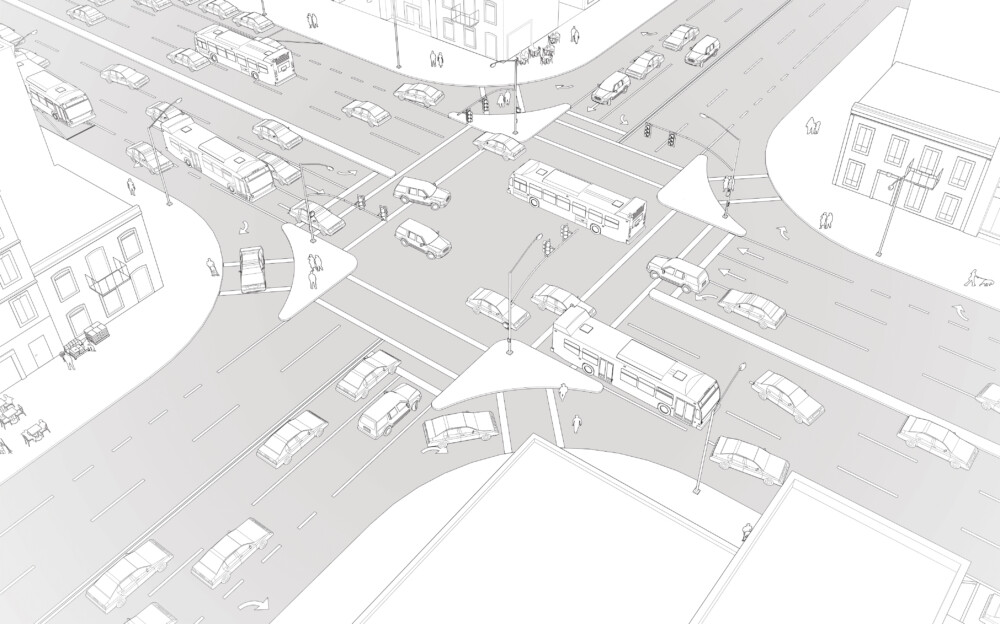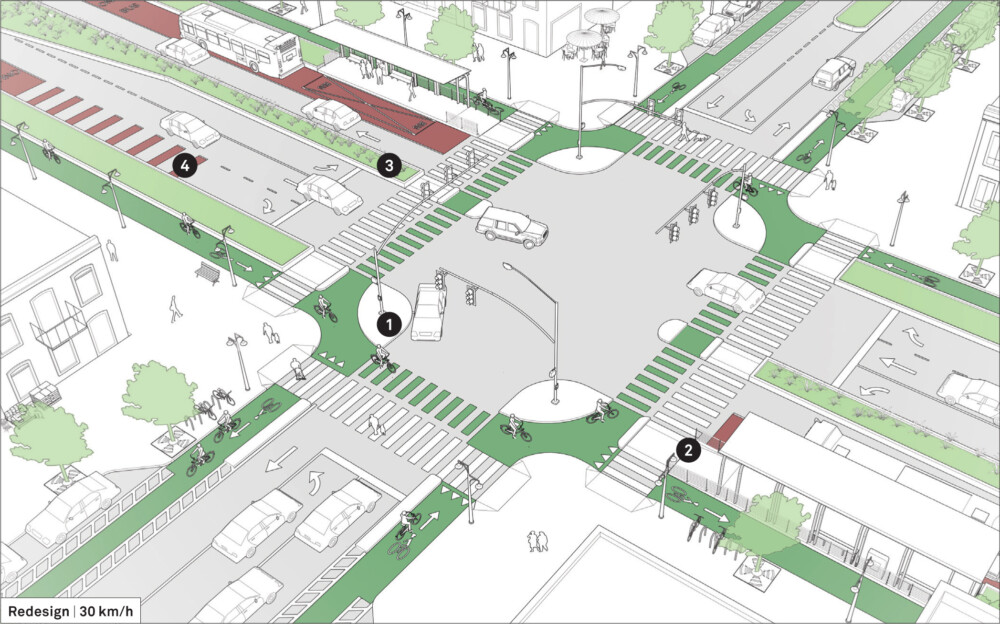-
About Streets
- Introduction
- Defining Streets
-
Shaping Streets
- The Process of Shaping Streets
- Aligning with City and Regional Agendas
- Involving the Right Stakeholders
- Setting a Project Vision
- Communication and Engagement
- Costs and Budgets
- Phasing and Interim Strategies
- Coordination and Project Management
- Implementation and Materials
- Management
- Maintenance
- Institutionalizing Change
- Measuring and Evaluating Streets
-
Street Design Guidance
- Designing Streets for Great Cities
- Designing Streets for Place
-
Designing Streets for People
- Utilities and Infrastructure
- Operational and Management Strategies
- Design Controls
-
Street Transformations
- Streets
-
Intersections
- Intersection Design Strategies
- Intersection Analysis
- Intersection Redesign
- Mini Roundabout
- Small Raised Intersection
- Neighborhood Gateway Intersection
- Intersection of Two-Way and One-Way Streets
- Major Intersection: Reclaiming the Corners
- Major Intersection: Squaring the Circle
- Major Intersection: Cycle Protection
- Complex Intersection: Adding Public Plazas
- Complex Intersection: Improving Traffic Circles
- Complex Intersection: Increasing Permeability
- Resources
Global Street Design Guide
-
About Streets
- Introduction
- Defining Streets
-
Shaping Streets
Back Shaping Streets
- The Process of Shaping Streets
- Aligning with City and Regional Agendas
- Involving the Right Stakeholders
- Setting a Project Vision
- Communication and Engagement
- Costs and Budgets
- Phasing and Interim Strategies
- Coordination and Project Management
- Implementation and Materials
- Management
- Maintenance
- Institutionalizing Change
-
Measuring and Evaluating Streets
Back Measuring and Evaluating Streets
-
Street Design Guidance
-
Designing Streets for Great Cities
Back Designing Streets for Great Cities
-
Designing Streets for Place
Back Designing Streets for Place
-
Designing Streets for People
Back Designing Streets for People
- Comparing Street Users
- A Variety of Street Users
-
Designing for Pedestrians
Back Designing for Pedestrians
- Designing for Cyclists
-
Designing for Transit Riders
Back Designing for Transit Riders
- Overview
- Transit Networks
- Transit Toolbox
-
Transit Facilities
Back Transit Facilities
-
Transit Stops
Back Transit Stops
-
Additional Guidance
Back Additional Guidance
-
Designing for Motorists
Back Designing for Motorists
-
Designing for Freight and Service Operators
Back Designing for Freight and Service Operators
-
Designing for People Doing Business
Back Designing for People Doing Business
-
Utilities and Infrastructure
Back Utilities and Infrastructure
- Utilities
-
Green Infrastructure and Stormwater Management
Back Green Infrastructure and Stormwater Management
-
Lighting and Technology
Back Lighting and Technology
-
Operational and Management Strategies
Back Operational and Management Strategies
- Design Controls
-
Street Transformations
-
Streets
Back Streets
- Street Design Strategies
- Street Typologies
-
Pedestrian-Priority Spaces
Back Pedestrian-Priority Spaces
-
Pedestrian-Only Streets
Back Pedestrian-Only Streets
-
Laneways and Alleys
Back Laneways and Alleys
- Parklets
-
Pedestrian Plazas
Back Pedestrian Plazas
-
Pedestrian-Only Streets
-
Shared Streets
Back Shared Streets
-
Commercial Shared Streets
Back Commercial Shared Streets
-
Residential Shared Streets
Back Residential Shared Streets
-
Commercial Shared Streets
-
Neighborhood Streets
Back Neighborhood Streets
-
Residential Streets
Back Residential Streets
-
Neighborhood Main Streets
Back Neighborhood Main Streets
-
Residential Streets
-
Avenues and Boulevards
Back Avenues and Boulevards
-
Central One-Way Streets
Back Central One-Way Streets
-
Central Two-Way Streets
Back Central Two-Way Streets
- Transit Streets
-
Large Streets with Transit
Back Large Streets with Transit
- Grand Streets
-
Central One-Way Streets
-
Special Conditions
Back Special Conditions
-
Elevated Structure Improvement
Back Elevated Structure Improvement
-
Elevated Structure Removal
Back Elevated Structure Removal
-
Streets to Streams
Back Streets to Streams
-
Temporary Street Closures
Back Temporary Street Closures
-
Post-Industrial Revitalization
Back Post-Industrial Revitalization
-
Waterfront and Parkside Streets
Back Waterfront and Parkside Streets
-
Historic Streets
Back Historic Streets
-
Elevated Structure Improvement
-
Streets in Informal Areas
Back Streets in Informal Areas
-
Intersections
Back Intersections
- Intersection Design Strategies
- Intersection Analysis
- Intersection Redesign
- Mini Roundabout
- Small Raised Intersection
- Neighborhood Gateway Intersection
- Intersection of Two-Way and One-Way Streets
- Major Intersection: Reclaiming the Corners
- Major Intersection: Squaring the Circle
- Major Intersection: Cycle Protection
- Complex Intersection: Adding Public Plazas
- Complex Intersection: Improving Traffic Circles
- Complex Intersection: Increasing Permeability
- Resources
- Guides & Publications
- Global Street Design Guide
- Intersections
- Major Intersection: Cycle Protection
Major Intersection: Cycle Protection


Existing Conditions
The above illustration shows the intersection of two large two-way streets, both with three lanes in each direction. This intersection is signalized.
This extremely wide intersection has an unbalanced allocation of space between modes. Wide corner radii and slip lanes prioritize motorists and encourage high-speed turns.
Long pedestrian crossing distances and a lack of refuge islands extend the conflict zone for pedestrians and increase the risk of being hit by a vehicle.
Cycle facilities are nonexistent so cyclists are exposed to unsafe conditions and conflicts with turning vehicles.
A lack of pedestrian ramps at the sidewalks and refuge islands results in an inaccessible intersection.
Vehicles turning across oncoming traffic without a dedicated signal phase present dangerous conditions to pedestrians crossing the street.

Mumbai, India

Bangkok, Thailand
Design Guidance
This reconstruction demonstrates an intersection design which prioritizes safety for all users and not just motorists.
Protected cycle tracks are provided in each direction on one street, and buffered cycle lanes are provided on each side of the street of the other.
![]() This protected intersection, also known as a Dutch intersection, provides safe refuge spaces for cyclists where the various cycle facilities meet; all cyclist turns become two-stage turns, and cyclists are given priority position using advanced stop boxes, leading signal priority, and smaller curb radii to slow vehicles turning across the cycle path. See: Designing for Cyclists.
This protected intersection, also known as a Dutch intersection, provides safe refuge spaces for cyclists where the various cycle facilities meet; all cyclist turns become two-stage turns, and cyclists are given priority position using advanced stop boxes, leading signal priority, and smaller curb radii to slow vehicles turning across the cycle path. See: Designing for Cyclists.
Dedicated transit lanes run adjacent to side-running cycle tracks, with boarding island stops to organize interactions between cyclists, transit vehicles, and transit riders at stop locations.
![]() The side-boarding transit island not only eliminates conflict between cyclists and transit vehicles, but provides additional refuge space and shortened crossing distance for pedestrians. Cycle tracks may be raised or at street-level through the boarding island, but must adequately consider strategies to encourage cyclists to yield to pedestrians.
The side-boarding transit island not only eliminates conflict between cyclists and transit vehicles, but provides additional refuge space and shortened crossing distance for pedestrians. Cycle tracks may be raised or at street-level through the boarding island, but must adequately consider strategies to encourage cyclists to yield to pedestrians.
Extend sidewalks and curbs to provide safer and shorter pedestrian and cycle crossings and protect them from motorized traffic.
![]() Remove slip lanes and add signalized turn lanes for vehicles turning across oncoming traffic. Design turn lanes by recessing the central median.
Remove slip lanes and add signalized turn lanes for vehicles turning across oncoming traffic. Design turn lanes by recessing the central median.
![]() When traffic volumes are relatively low, the transit lane may be shared with near-side turning vehicles. In this case, it is preferable to install a far-side bus stop configuration to minimize turning conflicts, which would impact boarding operations.
When traffic volumes are relatively low, the transit lane may be shared with near-side turning vehicles. In this case, it is preferable to install a far-side bus stop configuration to minimize turning conflicts, which would impact boarding operations.
Added medians play an important safety role, but they are also crucial for urban green networks, especially at intersections where the network can be disconnected. Add landscaping and plantings to these elements. See: Green Infrastructure.

Delft, The Netherlands
Adapted by Global Street Design Guide published by Island Press.
Next Section —